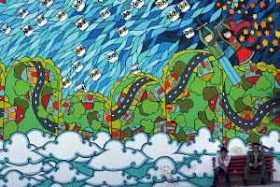The Mural Arts Community mourns the passing of our colleague and friend, Jose Ali Paz
October 16, 2008
Posted on Wed, Oct. 15, 2008
Jose Ali Paz, artist and activist, dies at 51 By John F. Morrison
Philadelphia Daily News
morrisj@phillynews.com
THE NORTH Philadelphia mural seemed like a daunting project for a man who had just had brain surgery - 120 feet long and 25 feet high.
But Jose Ali Paz had something to prove. The cancerous tumor that was removed by surgery was in the right side of his brain, the side that affects speech and creativity.
Jose was an artist. His whole life, his reason for being, what made him who he was, centered around his art.
The mural, on 5th Street near Allegheny Avenue, was his chance to prove that he could still create art.
"I wasn't sure he was able to do it," said fellow muralist Michelle Angela Ortiz. "I offered to do it on my own, but he had such a strong will, so much determination. He wasn't going to let his physical situation impair him."
Jose remained as the lead artist on the mural, "Life Reflects Nature: Memories of the Past, Traditions of the Present," which was dedicated in October 2005, a testament to the courage and resiliency of a determined will.
Jose Paz, who came to Philadelphia in 2000 to escape the political upheaval in his native Venezuela and found the ideal setting for his pursuit of art, died of brain cancer Saturday. He was 51 and lived in the Northeast.
He worked on numerous murals for the Philadelphia Mural Arts Program, undertook a wide variety of other art projects, including a poster depicting the Phillies' Latino players, and exhibited his own oils widely.
His paintings were mostly of scenes from Venezuela, landscapes and the people who worked the land and walked the streets of its cities and towns.
"It was great working with him," Ortiz, 29, said. "I'm the age of his oldest daughter, but he never treated me as an inexperienced artist. He always treated me with respect as an equal.
"After his surgery, he fought hard to retain his ability as an artist. Working on that mural was definitely therapy for him.
"When he saw what he was capable of doing, it gave him back his confidence."
Jose remained active in the mural program as late as last summer when he helped with the planning of the Girl Scout mural on Callowhill Street between Broad and 15th streets.
"He loved to paint," said Ortiz, an art teacher. "He would do anything in his power to keep going."
Taller Puertorriqueno is among the many organizations that benefited from Jose's talents and generosity. Dora Viacava, outreach coordinator for the group, said that Jose did volunteer work that even included acting in a street-theater demonstration.
He taught a water-color class for seniors, created a huge banner for Taller with the logos of companies and organizations that contributed to the group, and even painted the walls of Taller's headquarters on 5th Street near Lehigh Avenue to display the work of his senior students.
"He was a really wonderful, very humble person, very generous and friendly," Dora said. "I admired the way he was able to balance his life between his family and his work."
"He was an extraordinarily talented artist," said Jane Golden, director of the Mural Arts Program. "But most importantly, he was one of the nicest, most thoughtful people I ever met.
"He was generous and kind. The world is a sadder place with his passing."
Jose and his family were among the founding members of Casa de Venezuela, an organization of immigrants from Venezuela. He taught art to children and volunteered his talents in many ways for the group.
"He was a really happy guy," said Emilio Buitrago, president of Casa de Venezuela. "He loved to talk to people. He had a big smile. People knew he was there.
"He was always willing to help people whether he knew them or not. He was an amazing father and a great community activist."
Jose's daughter, Viviana Paz, one of his four children, said, "He was the best father. He was my friend, a person I could sit down with and talk about everything.
"He was full of experience, a very wise man. He knew about everything. Sometimes I would wonder how he knew so much. His head was like a whole library.
"He was not afraid of anything. When I feel I can't do something, I remember that my Dad did so many things. There is nothing you can't do, he told me. Everything is possible if you try it."
Jose came from the town of Merida, in Venezuela. He and his wife, Mary, were married 28 years ago. He began working as an artist in his native country, where he also was a magazine publisher, did photography and other commercial art work.
He didn't want to leave Venezuela, but with the political situation and the rise of president Hugo Chavez, he felt he had no choice. "He tried everything to stay," said his daughter, "but nothing worked."
She regretted that her father was "at the top of his profession when he got brain cancer."
Besides his wife and daughter, he also is survived by his mother, Esther; a son, Jose Jr.; two other daughters, Rusmery and Daniela; two sisters, Luz and Alba Paz, and two grandchildren, Diego, 5, and Davya, 3 weeks.
Friday, October 17—5:30 to 7:30 p.m.
Viewing Service
A. Andrew Compagnola Funeral Home
4405 N. 5th Street, Philadelphia, PA 19140
Saturday, October 18—10:00 a.m.
Funeral Mass
Incarnation of Our Lord Roman Catholic Church
5105 N. 5th Street, Philadelphia, PA 19120
Saturday, October 18—3:00 to 4:30 p.m.
Tribute to Jose Ali Paz
Taller Puertorriqueño—Education Building
2557 N. 5th Street
Philadelphia, PA 19133
Flowers, cards, and donations can be sent to the Paz Family in care of 451 Van Kirk Street, Philadelphia, PA 19120.
--








































